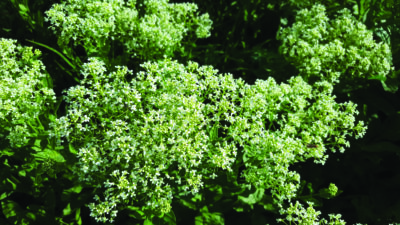BY BLAINE BUG CREW

One of the most easily recognized noxious weeds in Idaho is hoary cress, also known as whitetop. Most people call it whitetop because the whole top half of the plant is covered in white flowers. It’s too bad it’s so invasive because its white flowers are actually quite beautiful.
Whitetop is a perennial mustard that reproduces both vegetatively and by seed. This deep-rooted, creeping plant can grow to 90 cm tall and invade crops, riparian areas and rangelands. After its introduction into North America from Eurasia in the late 19th century, whitetop has spread aggressively and is now listed as “noxious” in at least 24 states. Leaves are grayish-green, lance-shaped, clasping, and up to 10 cm long. Flowers are white, 0.5 cm across and bloom from April to May. The conspicuous, dense flower clusters appear flat-topped early in the season, but this characteristic disappears as the stem elongates. Flowering stems contain an average of 2,300 seed pods. Seed pods are heart-shaped and contain two small, flat seeds that can remain viable for at least three years. We are excited to report that the U.S. Department of Agriculture is getting really close to the release a new biological control agent for this weed.
Ceutorhynchus cardariae, a stem-galling weevil, is the predator to whitetop. This monitoring protocol was designed to be implemented by land managers in a timely manner and to provide pre-release monitoring data that will enable land managers and researchers to accurately quantify the impact of Ceutorhynchus cardariae once it is released.
Until the release of this biological control agent on whitetop, it is important for landowners and the public to contain the spread of this noxious weed. If you are aware of an infestation of whitetop, it would be a good idea to call Kay Draper at the Blaine County Weed Department, (208) 788-5543. Thank you for doing your part to keep Blaine County native, green, and weed-free.
